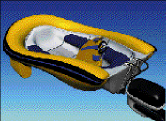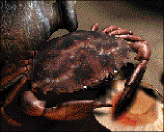By Stephanie Tripp
Art isn’t usually ranked among the most employable fields. But at BYU, visual arts students are learning that natural talent coupled with the experience they gain from BYU in the latest computer design software systems are landing them jobs–jobs in Hollywood and with major corporations.

George Xanthos, an industrial design student, used Alias to design this boat for Mercury Marine. Students have also worked with Hewlett Packard and General Motors.
The most recent examples include two students who have received recognition
for their work in the motion picture industry and two recent graduates who were hired by General Motors.
Dan Lemmon, a senior from Thousand Oaks, Calif., majoring in industrial design, spent his last two summers as an intern for Digital Domain, a company in Venice, Calif. There, Lemmon worked on the modeling, coloring, lighting, and compositing for two major motion pictures: The Fifth Element and Titanic.
Martin Havran, a senior from Provo majoring in illustration, also interned in the film industry, helping with the animation in Contact, starring Jodie Foster.
These students and others attribute their success to their exposure to Alias, a software package termed by reviewers as the “world’s best three-dimensional modeling computer software,” says Brent Adams, an assistant professor of visual arts who has worked with Alias/Wavefront to secure a $4.5 million donation of this software to the Visual Arts Department. The company provided 20 copies of each of the four programs (paint, animation, video editing, and modeling) offered in the animation and design software package, which has been used to create the toys in Disney’s Toy Story and the dinosaurs in Jurassic Park.
Major automobile companies, including General Motors, Ford, and Toyota, use Alias as well–only these companies don’t use the program to resurrect extinct animals, but to design cars. In fact, two BYU graduates–Kevin Ketchum and David Bentley–were hired by General Motors in 1996 mainly due to their exposure to Alias. “Because of their experience with the software, coupled with their abilities to sketch and draw and work with engineering students on a senior project, General Motors hired them and put them in a top studio,” Adams says. “These two students were hired over 25 students from transportation design programs that cost around $10,000 a semester.”

Using Alias – a three dimensional computer software program – Zhenhui Qian, an illustration major, created this model crab.
Adams attributes the success of BYU’s students not only to software experience, but to talent. “These are talented students who have access to software,” he says. “They have put in the hard work, and the software experience is the final tool that gets the industry interested in them.”
Vernan Wilbert, a 1996 industrial design graduate who now works for Digital Domain, attributes his hiring to his experience with Alias while a student at BYU. “The equipment they use in the industry is expensive, and they have a hard time finding individuals who know how to use it,” he says. “I was able to do my demo reel on Alias. If it wasn’t for that experience, I wouldn’t have the dream job I have today.”
Lemmon, who learned Alias at a summer job before having access to it at BYU, says he has seen what software knowledge can do for graduating seniors. “It has opened a lot of doors for people,” he says. “They will have opportunities in not just film and animation but in transportation and product design. It’s the real thing.”
Each semester, students majoring in industrial design, illustration, or interior design use programs like Alias and MicroStation (used primarily by interior design students) to complete semester projects. During fall 1997, several students from industrial design worked with Mercury Marine from Minneapolis, Minn., designing a new generation of boats. At the same time, the students have been working with Hewlett Packard making models for a new printer. This semester, the industrial design classes are designing a diesel car for General Motors.
Adams says the donations to the department have made many opportunities available to students. In fact, in the seven years since Adams has been a part of the department, he has been responsible for around $7.5 million in donations. These donations include a $650,000 computer lab from AT&T and a $1.5 million donation in computers and software from a company whose policy is to not give donations. Adams says the department has reached the point where they have to turn away donations that do not fit the department curriculum.
“These donations are substantial for an art department,” Adams says.
Adams is pleased with the chances the students have as a result of the donations. “It’s the opportunity for students to have a good income and a good career where they can make a difference in society. They are getting great opportunities for gain-ful employment.”









